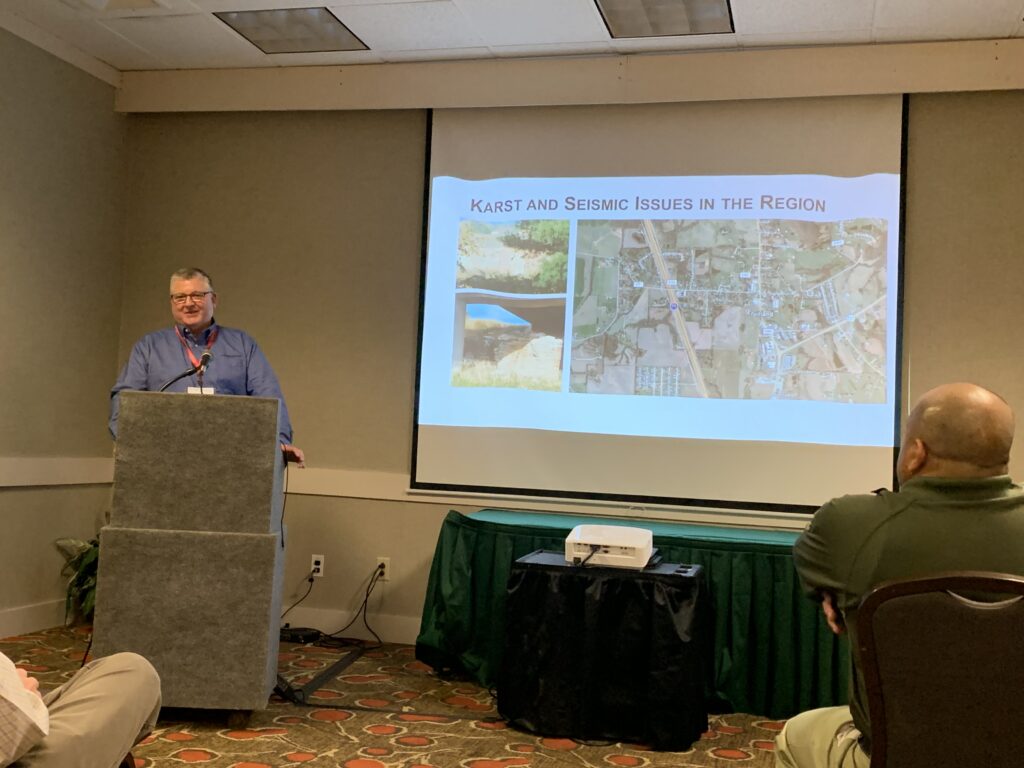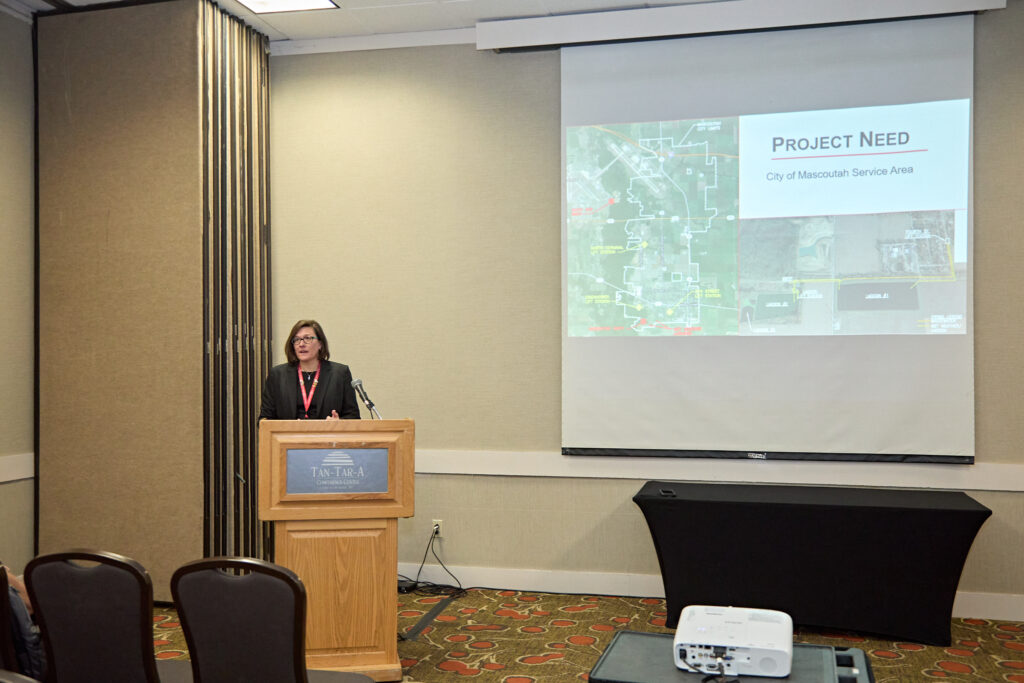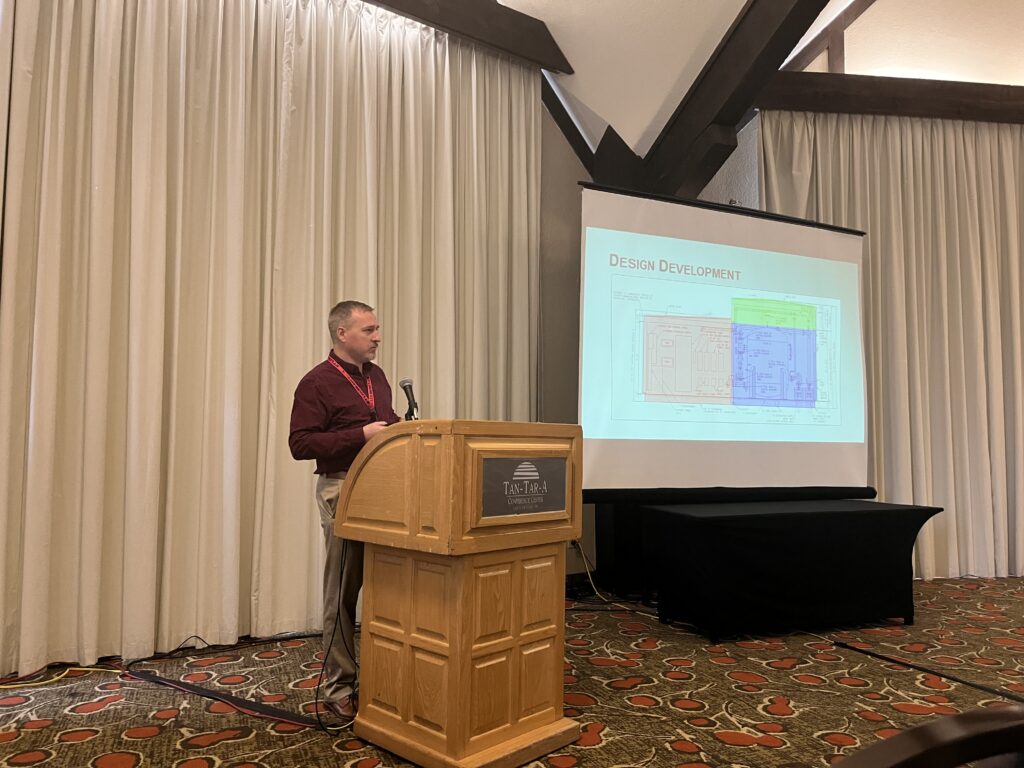April 14, 2023
H&S Presents at MWEA/AWWA JOINT Conference
H&S Water team members presented on various projects at the MWEA/AWWA JOINT Conference March 26-28.
Jim McCleish and Sean Mickey presented on the firm’s work at Cape Girardeau County Reorganized Common Sewer District Design.
The Cape Girardeau County Reorganized Common Sewer District regionalization project decommissioned over 23 existing permitted treatment facilities and utilized over 27 miles of sewer to combine flows to a new centralized wastewater treatment facility. The ideal site for the new central WWTF was determined to be on a segment of land donated by Fruitland American Meat. The existing site had an old terraced multicell lagoon that was originally designed as an “evaporative” lagoon system that was to be decommissioned and regionalized with the project. Though the cost was optimal, and the location was beneficial for sewage conveyance to a central plant, the local geology posed multiple challenges during design and construction.
Preliminary geotechnical borings on the site showed various rock elevations. The design team was suspicious of Karst features given experience in the region and proximity to fault lines. These issues can cause structural issues on any construction site resulting in property damage and loss of use, however, for a wastewater treatment facility utilizing an activated sludge process, loss/damage to key structures adds an environmental damage component to local waterways and could impact local groundwater supply wells. Additional challenges were introduced from geohydrologic evaluations performed by Missouri Geological Survey staff which gave the site sever rating and listed the preferred receiving stream as a losing stream with strict discharge limits.
To overcome karst issues and rock pinnacles, and even moderate size sinkholes if found during excavations, a structural design alternate was included to utilize grade beams to reinforce tank bottoms and bridge any karst features. The new treatment tanks, headworks, and effluent channels were designed on a common mat foundation to prevent differential settling and provide a single large foundation. The new SBR process was designed to provide a high quality effluent meeting losing stream requirements. The new UV disinfection designed with redundant capacity to allow year round disinfection, and the design included expansion capacity for nutrient removal and tertiary filtration. The plant has been online since Spring 2022, operated by Strickland Engineering, and producing the high quality effluent as required.

Christy Willson and Sean Mickey presented on the wastewater collection and treatment system upgrades at the City of Mascoutah, Illinois.
The Mascoutah STP had approached it’s life cycle expectations and was determined to need additional capacity to meet the City’s updated growth projections. Due to the additional capacity required, the new plant Design Average Flow (DAF) was expected to increase from 0.90 MGD to 1.75 MGD, which triggered additional effluent limits, including a TP limit of 0.5. The Facility Plan showed that the preferred alternative to expand capacity and meet new limits was to construct a new SBR plant next to the existing plant and use the existing facility for solids handling and wet weather flows.
The new SBR plant was designed to meet tight BOD and TSS limits along with utilizing enhanced biological phosphorus removal to minimize chemical costs. The aeration process was also designed to utilize nitrification/denitrification cycles to optimize energy use, even though no TN limits were introduced on the effluent. An alum dosing system and tertiary filter were also designed to polish and meet the TP limit below 1 mg/L. To allow sludge thickening without returning nutrient slugs back to the head of the plant, an automated decant system was utilized to allow the digester to decant without turning anaerobic. Additional systems included with the new plant expansion included a perforated plate automatic influent screen, online influent and effluent phosphate analyzers, and various transfer pump stations. The new Mascoutah STP system is nearing the end of construction with startup scheduled for November 2022.

Jim McCleish and Sean Mickey presented on Butler County PWSD #3 and their design-build project delivery of a new treatment system.
The existing Butler County PWSD #3 WTP was constructed over 50 years ago, and aging equipment and plant infrastructure led to the required replacement of the full facility. Raw water quality requires iron and manganese removal, with minimal additional treatment necessary for potable use. Due to the costs of complete facility replacement and condition of all existing facilities, alternate project delivery methods were evaluated to meet the District’s budgetary needs.
Previous alternative evaluations showed that the preferred alternative was to construct a new pressure filtration system with chlorine feed and greensand media for the iron and magnesium removal plant, although the expected cost was well beyond expectations of the District. To save construction costs, it was shown that a factory-built treatment system pre-installed in prefabricated building segments would provide significant cost savings vs. being fully built on site in a new process treatment building.
With a pre-procurement purchase order agreement and an engineer already on contract, the District was able to move forward with a hybrid project delivery method in which the process equipment manufacturer, factory assembler, and engineer were able to work together during the design phase to develop general construction plans and specifications for the new factory built water treatment plant to be installed on site. This project delivery method has allowed the project to be executed within the District’s budget and is currently in fabrication with expected facility startup by March 2023.




